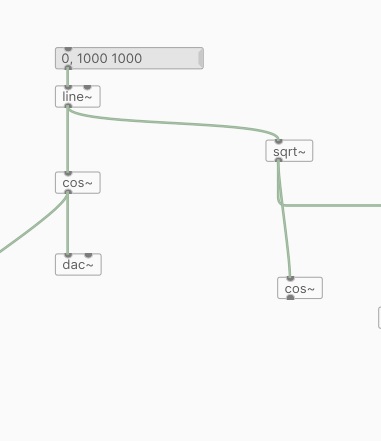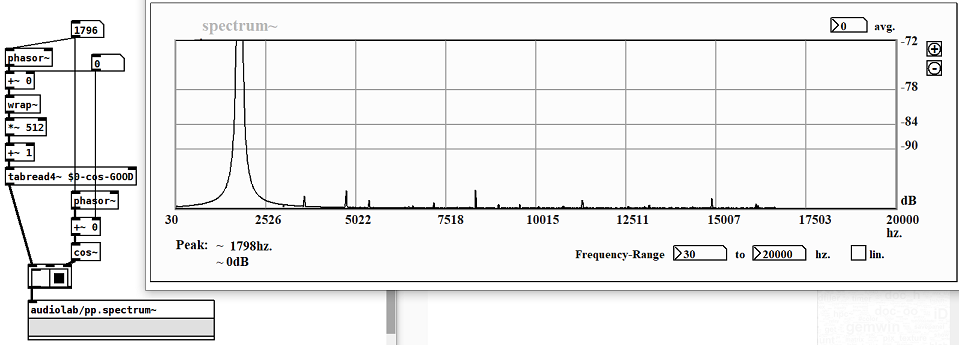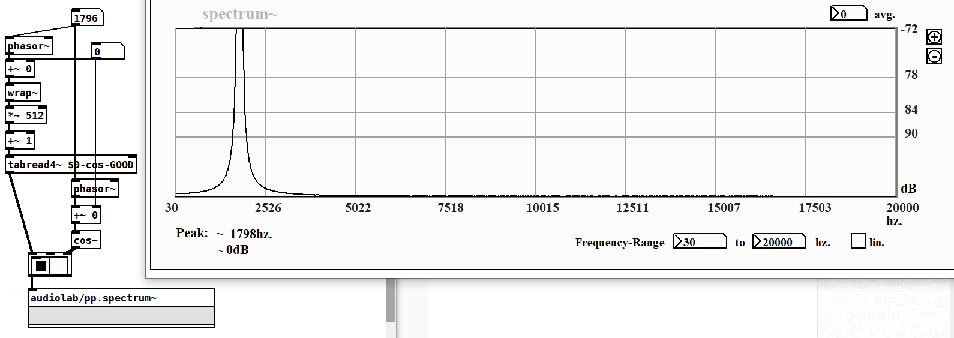When feeding a line~ with message 0, 1000 1000 into a cosine
So , play 1000 during 1000 ms there is severe aliasing but only after 500 ms of playing ( see sidebands )


Aliasing line ~ ?
When feeding a line~ with message 0, 1000 1000 into a cosine
So , play 1000 during 1000 ms there is severe aliasing but only after 500 ms of playing ( see sidebands )


@gentleclockdivider Sounds unaliased to me
imo this is a weird usage of [cos~]. why not just feed a single frequency into [osc~]? anywaways if you are set on doing it this way you could try using [vline~] and see if it's any better because [vline~] uses doubles. you could also try using [wrap~] before [cos~].
but you might also be getting artifacts in the spectrogram from a sudden change in frequency (to 0)...
edit: basically it's not recommended to use large numbers to drive [cos~] but I forget if [wrap~] helps or not. the error might be present at that point already..
edit2: personally I use my own sine tables if I want really clean sine waves because the ones pd uses internally still sound a bit gritty to me sometimes, I think they use 512 points and I usually end up using tables that use 2048 or 4096 points
@seb-harmonik.ar said:
the error might be present at that point already..
yes, it might be a precision-thing.
Comparing Pd's [cos~]ine-table with [tabread4~ $0-cos-GOOD] from this patch:
https://github.com/pure-data/pure-data/issues/105
(see https://forum.pdpatchrepo.info/topic/13709/bug-osc-cos-circle-asymmetry-drifting-out-of-phase )
Driving them with a large number added, same artefacts appear.
Offtopic, but
without any addition [+~ 0] $0-cos-GOOD is slightly cleaner:


Sounds unaliased to me
< -90 dB we can't hear that.
late EDIT:
since Pd 0.55 and ongoing, Pd's cosine table has changed to a higher resolution and might get further changes for symmetry. See release notes and https://lists.puredata.info/pipermail/pd-dev/2024-06/023715.html
@lacuna I think there might be error in the increment with large numbers as well.
as in the internal 32-bit floats in [line~] will increment the internal representation with less accuracy for larger numbers as well, whereas [phasor~] will at least store the correct number internally.
I see, all kinds of precision errors in every stage. Didn't know [vline~] was calculating in double-precision. Thank you!
And didn't see your 2nd edit:
@seb-harmonik.ar said:
edit2: personally I use my own sine tables if I want really clean sine waves because the ones pd uses internally still sound a bit gritty to me sometimes, I think they use 512 points and I usually end up using tables that use 2048 or 4096 points
Here is a rather messy patch comparing different tables and interpolations I started to make a while ago, maybe worth sharing here:
Bigger tables are more robust against precision errors (offset) of their driving inputs.
With offset, [cyclone/cycle~] has same few artefacts for smaller as for bigger arrays (hmm..might be a bug I did?).
[osc~] is the cheapest sine.
[cyclone/cycle~] has non-expected costs with different interpolations.
My linear interpolation is different than cyclone's in results and very expensive (due to vanilla patching!?).
At an offset above [+~ 1023], with [cos~] and 512-point-table called $0-cos-GOOD, there is a sudden increase of artefacts .(due to bit-depth!!?)
There might be bugs. Sorry for the mess, too boring cleaning up this time.
you dont want to go to 1000 in 1000, you want to go to 1.
Oops! Looks like something went wrong!